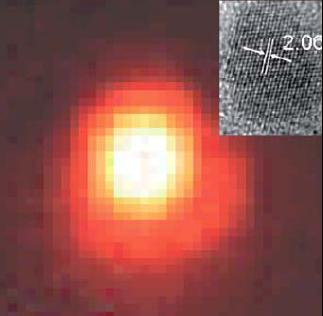A joint team of researchers from French research institutes and the University of Stuttgart in Germany discovered a new method for producing radiating nanoparticles from diamond microcrystals.

Fluorescence is a significant tool in the life sciences and materials. In the fields of biology and medicine, the connection of fluorescent dyes to proteins or nucleic acids (DNA and RNA) allows researchers to follow the activity of these important substances in cell cultures or in the living body itself. In addition, the method is accepted in materials science for measuring electromagnetic fields, for optical storage and for identifying counterfeit products. However, most of the radioactive dyes are composed of particles with a limited lifespan due to their internal chemical activity.
In this context, radiative diamond nanoparticles present a valuable alternative thanks to their extraordinary photophysical properties. They are extremely bright and have uniform and continuous long-term radiation in the red or near-infrared (NIR) radiation range. Based on these unique properties, many applications are expected in the fields of physics, materials science, biochemistry, biology and medicine. However, until recently the production of these nanoparticles was limited to the laboratory only.
Now, researchers are looking at a method to produce such radiant nanoparticles. The method includes irradiation of nitrogen-rich diamond nanocrystals, produced in the diamond industry, using an electron or ion beam to create cavities within the crystal lattice. In the next step, the nitrogen atoms "capture" these moving spaces during the annealing process to create a radiant core. Unfortunately, the efficiency and utilization of this process is low due to the non-uniformity of the structures and the loss of voids in favor of the surface during screening and annealing.
"Top-down" (top-down) processing of diamond microcrystals, which is less sensitive to the shortcomings described above, would be a more appropriate industrial route. However, in this case, two bumps in the road must be overcome - the difficulty in irradiating a large amount of material and converting the microdiamonds into nanocrystals while preserving the fluorescence properties and the crystalline structure.
In a contemporary study, published in the scientific journal Nanotechnology, researchers from France and Germany have successfully tested this alternative method for creating uniform samples of tiny and very clean radiating diamond nanoparticles, while obtaining high utilization.
The manufacturing process begins with the projection of diamonds whose micron size is closely controlled, those obtained after additional cleaning and polishing steps. In this state-of-the-art procedure, nitrogen-containing micro-diamonds with a defined atomic composition were irradiated by a high-energy electron beam and in the next step were annealed at a high temperature of eight hundred degrees Celsius to create desired photo-radiant cores within the crystalline lattice without damaging its integrity.
An original two-step polishing process was developed to transform radiating microdiamonds into extremely tiny round nanoparticles (about four nanometers in diameter) with the purest diamond properties with extremely bright and stable photoradiant cores.
Such a precise manufacturing process can now be used for the industrial production of radiating diamond nanoparticles. With this method, the properties of diamonds can be changed at will according to the composition of the starting materials and this in response to the changing needs of future applications. These radiant diamond nanoparticles pave the way for the practical development of long-term labeling, of quantitative biology and innovative technological applications in analytical chemistry, optical electronics components and state-of-the-art composite materials.
